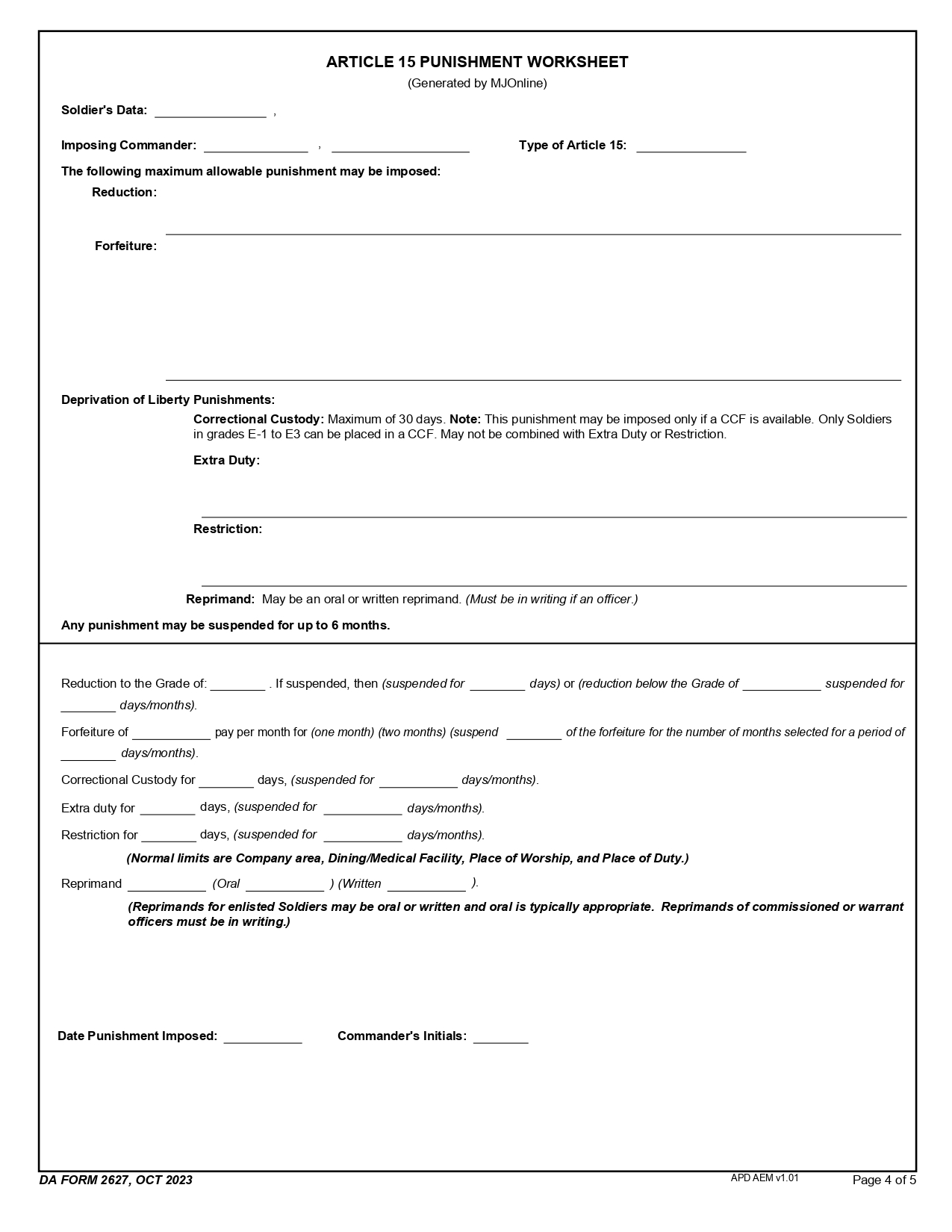DAFORMFILLABLE.COM | DA FORM 2627 Fillable – Army Pubs 2627 PDF – DA FORM 2627, formally titled Record of Proceedings Under Article 15, UCMJ, is a critical document in the administrative processes within the United States Army. This form plays a pivotal role in the non-judicial punishment system under Article 15 of the Uniform Code of Military Justice (UCMJ). This article provides an in-depth look at DA FORM 2627, its purpose, usage, and significance in maintaining military discipline and order.
DA FORM 2627 – Record Of Proceedings Under Article 15, UCMJ
| Form Number | DA Form 2627 |
| Form Title | Record Of Proceedings Under Article 15, UCMJ |
| Form Date | 10/01/2023 |
| Form Proponent | TJAG |
What is DA FORM 2627?
DA FORM 2627 is used to document the proceedings and results of non-judicial punishment (NJP) as authorized by Article 15 of the UCMJ. The form was most recently updated on October 1, 2023, and it is prescribed by AR 27-10. The proponent of this form is The Judge Advocate General (TJAG). This form is unclassified and approved for public release, with distribution being unlimited.
Purpose of DA FORM 2627
Non-Judicial Punishment Explained
Non-judicial punishment is a disciplinary measure more informal than a court-martial, allowing commanders to address minor offenses committed by military personnel. The use of DA FORM 2627 ensures a standardized record-keeping process that documents the facts, decision, and penalties associated with these proceedings.
Importance of a Standardized Form
The form serves multiple important functions:
- Record Keeping: It provides a permanent record of the facts and outcomes of the Article 15 hearing.
- Legal Documentation: It serves as evidence in future judicial or administrative actions.
- Rights and Appeals: It outlines the rights of the accused, including the right to appeal the commander’s decision.
Sections of DA FORM 2627
DA FORM 2627 is meticulously structured to capture all relevant information pertaining to the non-judicial proceedings. Here’s a breakdown of its key sections:
Part I: Proceedings
This section records the personal details of the accused, the specific allegations, and the commander’s findings. It is crucial for establishing the basis of the proceedings.
Part II: Rights of the Accused
Here, the rights of the accused are clearly listed, including the right to remain silent, the right to be represented, and the right to present evidence.
Part III: Election of Rights
In this section, the accused must indicate whether they accept the proceedings under Article 15 or prefer a court-martial.
Part IV: Findings and Punishments
This final section documents the commander’s findings and the punishment imposed if the accused is found guilty.
Legal and Practical Implications of DA FORM 2627
DA FORM 2627 not only serves as a critical legal document but also as a tool for maintaining discipline within the ranks. The decisions documented in this form can have significant impacts on a service member’s career and personal life, highlighting the importance of accuracy and fairness in the proceedings.
Conclusion
DA FORM 2627 – Record of Proceedings Under Article 15, UCMJ, is an essential element of the military justice system, providing a framework for handling minor offenses within the military. Understanding how to properly fill out and process this form is crucial for military leaders and legal personnel. The standardized approach ensures fairness and uniformity in the handling of disciplinary actions across the U.S. Army, reinforcing the principles of justice and order that are fundamental to military service.
For professionals in the military or legal fields, mastering the use of DA FORM 2627 is key to effectively managing non-judicial punishments and upholding military discipline.
DA FORM 2627 Fillable – Army Pubs 2627 PDF DOWNLOAD




